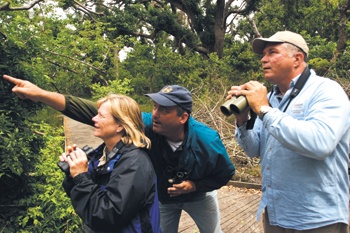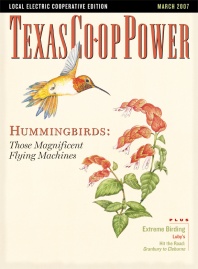Bill Baker brings the van to a stop in the middle of the road, kills the engine and lights. A “shhh,” from Cecilia Riley in the front seat. Rain is drumming the roof. Tom Roberts and I crack the back windows and try to listen through it: the faint whisper of wind through pine needles, a low rumble of far-off thunder, the occasional sickening whine of mosquito wings in your ear. Sheet lightning opens the sky, silhouetting tall, spindly pines that surround us. We wait like statues, ears cocked. Minutes pass, but nothing. Soon, the rain has turned to a roar.
We are on a minor logging road somewhere deep in the Angelina National Forest, outside Jasper in the Piney Woods of East Texas. It’s 5:28 a.m. What would bring a person to this place at this hour? Not fame, nor the promise of money. Not the love of a man or woman, or the hope of spiritual enlightenment. Not anything but the pure and simple pleasure of seeing (and/or hearing) a bird. And bragging rights.
It is April 26, 2006, day two of what may be the most extreme birding competitions on earth—The Great Texas Birding Classic. The weeklong event, now in its 11th year, pits three- and four-member teams in a five-day test of endurance and birding skill. From the Piney Woods to the shores of South Padre Island, teams zigzag along the 600-mile Great Texas Coastal Birding Trail by car and boat and on foot. They brave cold, heat and rain, deep woods, remote wetlands, biting deerflies, and clouds of mosquitoes so thick you have to breathe through your teeth. They sleep scant hours in campgrounds and cheap hotels, subsist on trail mix, gas station coffee and Whataburger to-go. All in pursuit of a simple, singular goal: identify the most birds (and win).
For a glimpse of what people who would put themselves through this are like, I have joined the Reliant Energy Environmental Partners team for one leg of its journey. With two native Texans, Baker of League City and Riley of Lake Jackson (plus Roberts of Johnstown, Pa.), the trio is the home team. As winners of the 2005 competition, they are also a favorite for 2006. Their most-feared rivals are the Nikon Wildbirders—an all non-Texan team that has dominated the competition in several previous years. The middle-aged Environmental Partners are ever-conscious of the relative youth of the Wildbirders, who are in their late 20s.
“They have a lot of energy,” Bill says. He suspects they sleep less and knows they move more quickly. But because each team sets its own routes and tallies are not submitted until the final day, competitors are left to wonder and worry over their standing all week long. Besides the ghosts of their rivals, their constant enemy is time. It bears down on them always. You don’t walk back from a bathroom break, you jog—or run.
4:32 a.m.
Best Western, Jasper
For Bill, the day begins with a cola, a cup of orange juice with a tear-off aluminum lid and a sad warmed-over breakfast-in-a-bun—a tiny sausage wrapped in dough—from the hotel’s continental breakfast offerings. He is the first team member to reach the lobby and is surprisingly alert, enthusiastic and friendly for this hour. Bill, the team’s logistician and driver, has been scouting and planning the route for the past year, intensively for the past month. His meticulous planning was crucial in its 2005 victory and has made the team the first in competition history to spy both the elusive whooping crane and the Atwater’s prairie chicken. In their first 24 hours, the trio already has logged an impressive 173 species and covered 400 road miles.
“I’m just the driver,” Bill says modestly. He tells me that Tom and Cecilia are the real birding experts, calling them both “ringers.”
4:55 a.m.
Outside of Jasper
It will be another hour before sunrise. The team is loaded in the van and moving toward the Angelina National Forest—its first predetermined location. We are in pursuit of a red-cockaded woodpecker and hope to pick up an owl and a few other nocturnal species. Tom is beside me in the back seat. His enthusiasm is tangible. “It’s tough to go to sleep,” he says. “You’re too excited thinking strategy: Did I mark every bird? Where are the gaps, and what are we hoping for the next day?”
As we turn down a forest road he describes the Texas coast as a converging point for migratory species, a geographic bottleneck that brings a stunning variety and abundance of birds every spring. This is why Tom has made his own pilgrimage to compete for the past six seasons. “It’s incredible to see birds and know that they are 600 miles into their journey,” he says.
6:02 a.m.
Angelina National Forest
The rain has slowed to a drizzle, and we see the first faint hints of daybreak. The team gets out of the van to stand side by side in the middle of the road, eyes trained on a cluster of thin dead pines. I can just make out their outline in the growing light. A few more moments, and I can see them plainly. The team scans the cluster with their binoculars.
“There,” says Tom, pointing. “Screech owl. Do you see it? Top right limb of the center tree.”
“Yes, yes, yes” Cecilia says.
“Got it!” Bill says.
“Do you see it?” Tom asks me. I lean over to follow his point and can see the small figure of an owl on one of the high branches. A thin hollow “hoo” emanates from the cluster. I feel a chill of excitement. Tom hands me his binoculars and I find the owl again. It “hoos” once more then takes to the air and flaps out of sight. My heart is beating more rapidly as I hand the binoculars back.
“Cool,” I say lamely. Tom seems pleased. He can see that already I am beginning to understand what has brought them here
In a few minutes, we see the red-cockaded woodpecker. It emerges from a hole in the trunk of one of the trees just as Bill said it would. Over the next half hour, the team also catalogs a kestrel, a Chuck-will’s-widow and a pine warbler.
“All targets are here,” announces Bill. The team is all smiles as we head for the van.
“I’m so relieved,” Cecilia says. “I’ll be even more relieved when we get a brown-headed nuthatch.”
View from the Finish Line
The team would add another 64 species before the end of the day. (I have been asked not to reveal where we went or how we got there.) By the tournament’s close, they had reached their pre-race goal of 340 birds—enough to repeat their championship. The Wildbirders finished second with 325 species.
As grand prize, the Environmental Partners were awarded the honor of presenting a $20,000 grant in their name, earmarked for a habitat restoration project near Corpus Christi. They logged 2,450 miles in the van—about average for most teams, according to Bill.
The trio is already looking forward to 2007. “Planning began just after the awards brunch,” Bill says. “We always talk about what we did well and what we can do better next year.”
The Classic, 2007
Co-sponsored by the Gulf Coast Bird Observatory and the Texas Parks and Wildlife Department, the 11th annual Great Texas Birding Classic will be held April 15-22. In addition to the weeklong tournament, the Classic offers a variety of day tournaments organized by age group (from children to seniors) and special areas of interest. For the armchair birder, there is even “The Big Sit,” an all-age, 24-hour competition where, basically, team members let the birds come to them. Events are held along the entire coast with competition headquarters in Lake Jackson, Port Aransas and McAllen. For additional information go to: http://www.tpwd .state.tx.us/huntwild/wild/birding/gtbc/ or contact Tournament Coordinator Carol Jones at (979) 480-0999.
The areas in this story are served by Cherokee County, Deep East Texas and Jasper-Newton electric cooperatives.
Jody Horton, an Austin-based writer and photographer, wrote “Green by Design” in the June 2006 issue.


